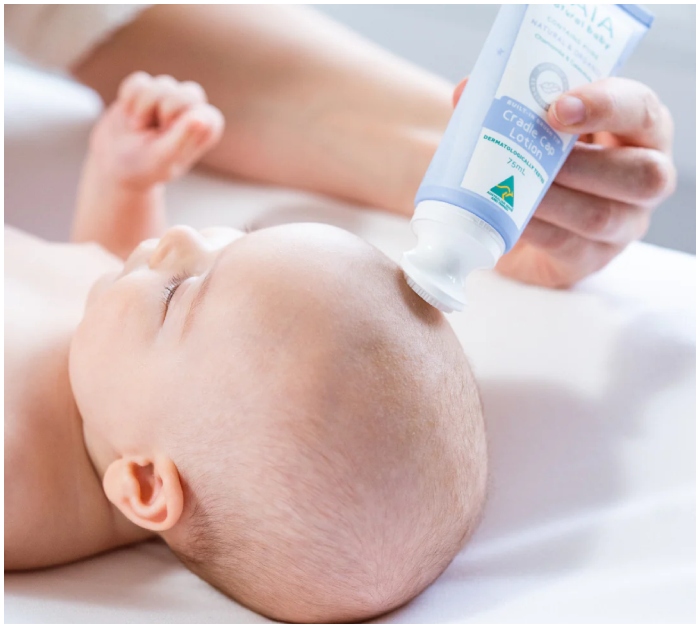Cradle cap, known medically as infantile seborrheic dermatitis, is a common and typically harmless condition that affects many infants. Characterized by crusty or oily patches on a baby’s scalp, it can sometimes appear daunting to parents. However, with the right care and treatment, managing cradle cap can be straightforward. While it often resolves on its own, persistent cases may require attention and treatment to alleviate symptoms effectively.
Understanding Cradle Cap and Its Treatment Options
Cradle cap usually clears up on its own, but there are times when intervention may be necessary to manage or expedite recovery, especially if the condition seems to persist or worsen.
Medical Treatments
In cases where cradle cap doesn’t improve with basic home care measures, consulting with a pediatrician is advisable. They may recommend:
- Low-potency hydrocortisone cream: Useful for soothing inflammation and irritation. It’s important to use only a low-potency cream specially formulated for infants, as their skin is very sensitive.
- Antifungal ketoconazole shampoo (2%): This can be effective in treating the yeast growth that can exacerbate cradle cap. It is crucial to use this shampoo under medical supervision and to avoid contact with the baby’s eyes, as it can be irritating.
Before using over-the-counter treatments like cortisone or antifungal creams, it’s vital to consult with your baby’s healthcare provider. Many products available for adults and older children are not suitable for infants’ delicate skin. Additionally, shampoos containing salicylic acid should be avoided for babies, as they can absorb the active ingredients through their skin, which could lead to adverse effects.

Home Care Remedies
Effective management of cradle cap often involves simple home remedies that can be implemented with ease:
- Gentle Scalp Massage: Regularly massaging your baby’s scalp with a soft brush or cloth can help loosen and remove the scales associated with cradle cap.
- Regular Shampooing: Using a gentle baby shampoo daily can help reduce the build-up of scales. After applying shampoo, softly brush the scalp with a baby brush or fine-tooth comb to help dislodge flakes before rinsing.
- Moisturizing the Scalp: For stubborn scales, applying a small amount of natural oils like coconut or almond oil can be beneficial. These oils can soften the scales, making them easier to remove during subsequent shampooing. Be sure to wash the oil out thoroughly to prevent further buildup.
- Maintaining Scalp Cleanliness: Once the condition is under control, reduce shampooing to a few times a week to prevent irritation and maintain scalp health.
Preparing for Your Pediatrician Visit
If you decide to seek medical advice for your baby’s cradle cap, being prepared for the consultation can facilitate a more effective visit. Be ready to discuss:
- The duration and history of the cradle cap.
- Any home remedies you have tried.
- How frequently you have been shampooing your baby’s hair.
- Any products, particularly new ones, that you have applied to your baby’s scalp.
This information will help your healthcare provider tailor the most appropriate and safe treatment plan for your baby.

Monitoring and Long-term Care
Regular monitoring of your baby’s scalp is crucial for managing cradle cap effectively:
- Watch for Signs of Infection: If you notice increased redness, swelling, or if the affected area starts spreading beyond the scalp, it might be indicative of an infection or another underlying skin condition requiring professional medical treatment.
- Regular Follow-ups: If your pediatrician prescribes treatment, regular follow-ups are necessary to ensure the treatment’s effectiveness and make adjustments if needed.
Educating Yourself and Setting Realistic Expectations
Understanding that cradle cap is a common and typically non-serious condition can alleviate much of the worry associated with it. Most infants outgrow cradle cap without any lasting effects, and it rarely causes discomfort to the child. However, the cosmetic appearance can be concerning to parents, and knowing how to properly care for your baby’s scalp can prevent the condition from worsening.
In conclusion, while cradle cap is a common condition among newborns, effective treatments and simple home care strategies can manage and resolve it without complications. Always consult with a healthcare provider before starting any new treatment to ensure it is safe and appropriate for your baby’s delicate skin. With the right approach, your baby’s cradle cap can be nothing more than a minor and temporary concern.